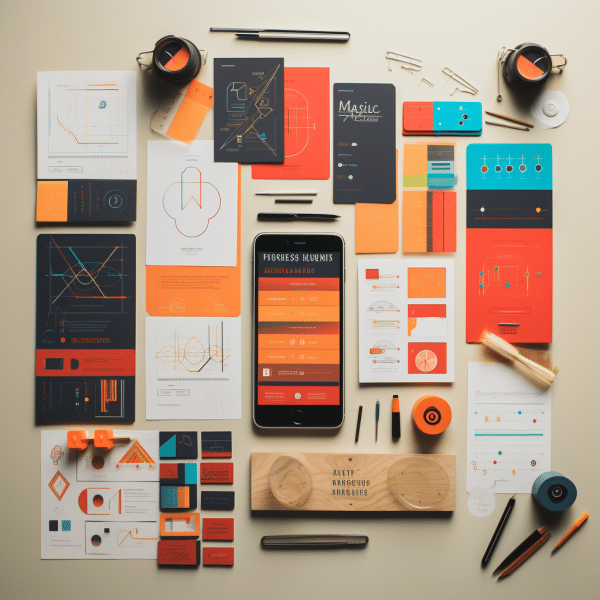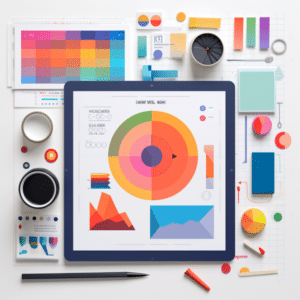
Welcome to the world of UI/UX design, where user interface and user experience come together to create seamless and enjoyable experiences on websites. As a designer, understanding and implementing the key principles of UI/UX design is crucial to deliver effective solutions that solve specific user problems. In this article, we will explore the essential design principles that every designer should know.
UI/UX design principles encompass a range of concepts that drive the creation of user-centered designs. By focusing on user needs and preferences, designers can enhance usability, establish visual hierarchy, and create interactive designs that engage users. Let's delve into the key principles that will help you master UI/UX design.
Key Takeaways:
- UI/UX design principles are essential for creating effective websites.
- User-centricity and understanding user problems are fundamental to UI/UX design.
- Consistency in design elements and meeting user expectations improves the user experience.
- Hierarchy and information architecture guide users through a product.
- Contextual design considers real-world situations for optimized user experiences.
User-centricity: Putting the User First
When it comes to UX design, one of the fundamental principles is user-centricity. This principle emphasizes the importance of putting the user first in the design process. By focusing on the needs and problems of the user, designers can create products and services that effectively solve those problems.
In order to achieve user-centricity, conducting user research is key. This involves gaining a deep understanding of the target users' preferences, behaviors, and pain points. By gathering insights through interviews, surveys, and observations, designers can gain valuable information to inform their design decisions.
Another crucial aspect of user-centricity is user testing. By involving users in the testing phase, designers can gather feedback and identify areas for improvement. This iterative process ensures that the final product meets the users' needs and expectations, resulting in a more satisfying user experience.
User-centricity in UX design means creating products and services that solve user problems and prioritize the user experience. By conducting user research and testing, designers can gain valuable insights on how to meet users' needs effectively.
By following the principle of user-centricity, designers can create user-centered designs that prioritize the user's experience. This approach not only improves usability but also increases user satisfaction and engagement. By understanding and addressing user problems, designers can create products that truly resonate with their target audience.
| User-centricity Benefits | User-centricity Challenges |
|---|---|
|
|
By embracing user-centricity, designers can create products and services that truly resonate with their users. By understanding user problems through research and testing, designers can ensure that their designs effectively meet user needs and enhance the overall user experience.

Consistency: Creating a Cohesive User Experience
Consistency is a fundamental UX design principle that plays a crucial role in creating a cohesive and intuitive user experience. It involves ensuring that design elements, both visually and functionally, are consistent throughout the website or app. By maintaining consistency, designers can meet user expectations and provide a seamless navigation experience. Designers should pay attention to various aspects of consistency, including visual design, interaction patterns, and content organization.
The Importance of Visual Consistency
Visual consistency refers to the uniformity of design elements such as colors, typography, and layout. It ensures that users can easily recognize and understand the purpose of different elements within the interface. When the visual design is consistent, users can quickly become familiar with the website or app, enabling them to navigate and interact with confidence. Consistency in visual design also helps establish a strong brand identity and reinforces the overall user experience.
Ensuring Functional Consistency
Functional consistency focuses on ensuring that the behavior and interaction patterns of elements remain consistent across different pages and screens. For example, if a button performs a specific action on one page, it should perform the same action consistently throughout the entire application. Functional consistency eliminates confusion and reduces the learning curve for users, allowing them to accomplish tasks more efficiently. By providing familiar and predictable interactions, designers can enhance the usability of the product and improve the overall user experience.
"Consistency is key in UX design. It helps users navigate and interact with a product effortlessly, reducing cognitive load and frustration. By establishing clear design patterns and guidelines, designers can create a cohesive experience that builds trust and satisfaction." – UX Designer
Designers can achieve consistency by following design systems, style guides, and pattern libraries. These resources provide a set of predefined design elements and guidelines that ensure consistency across different products and platforms. They help designers maintain a unified visual language and provide a seamless user experience.
| Visual Consistency | Functional Consistency |
|---|---|
| Consistent color scheme | Uniform interaction patterns |
| Consistent typography | Consistent button behaviors |
| Consistent layout and spacing | Consistent form validation |
By prioritizing consistency in both visual design and functional aspects, designers can create a cohesive user experience that promotes usability and builds user trust. Consistency enables users to navigate and interact with a product intuitively, ensuring that their expectations are met and enhancing their overall satisfaction. By providing a consistent experience, designers can create a positive impression of the brand and improve user retention and engagement.
Hierarchy: Guiding the User's Journey
Hierarchy is a critical UX design principle that shapes how users navigate through a product. It involves organizing information architecture and visual hierarchy to guide the user's journey. Information architecture determines the overall structure and organization of the website or app, while visual hierarchy focuses on the layout and prominence of individual elements. By prioritizing important elements and providing clear navigation, designers can help users easily find what they need and improve the user experience.
Importance of Information Architecture
Information architecture plays a vital role in creating a user-friendly experience. By carefully structuring and organizing the content, designers can ensure that users can quickly locate the information they're seeking. A well-designed information architecture considers the user's expectations and mental models, grouping related information together and providing logical pathways for navigation.
For example, an e-commerce website can employ a hierarchical structure with categories and subcategories, allowing users to navigate through different product sections. This clear organization helps users understand where they are in the site and find the specific items they're looking for. Additionally, information architecture influences the way search engines index and rank a website, impacting its overall visibility and SEO performance.
Visual Hierarchy and User Attention
Visual hierarchy is another crucial aspect of guiding the user's journey. By strategically using design elements such as size, color, contrast, and placement, designers can direct the user's attention to important information or actions. For instance, a bold and large headline at the top of a webpage instantly grabs the user's attention and communicates the main message. Contrast can be used to highlight interactive elements or call-to-action buttons, making them stand out from the rest of the content.
Designers must consider the importance of elements and their relative placement on the page. By arranging content in a visually appealing and intuitive manner, designers can guide users through the desired flow and prevent confusion or frustration. Effective visual hierarchy ensures that users can quickly scan and understand the content, facilitating a seamless user experience.
| Importance of Elements | Placement | Visual Effects |
|---|---|---|
| Key actions or features | Front and center | Contrast, color, size |
| Secondary content | Less prominent but still accessible | Subtle contrast, smaller size |
| Supporting information | Less prominent, visually separated | Reduced contrast, smaller size |
| Unimportant or supplementary content | Minimal prominence or hidden | Low contrast, small size, subtle placement |
By applying the principles of information architecture and visual hierarchy, designers can create a user-centered design that guides users through their journey and ensures a satisfying user experience. The next section will explore the importance of context in UX design and how it influences the overall user experience.
Context: Designing for Real-world Situations
When designing user experiences, it's crucial to consider the context in which users will interact with the product. The user's environment, device, location, and emotional state can all significantly impact their experience. By understanding these user experience factors, designers can create tailored experiences that address potential limitations and optimize usability.
For example, imagine designing a mobile banking app. Users may be accessing the app while on the go, in a crowded area, or even during moments of stress. By considering the user's context, designers can optimize the app's interface to be easily readable in varying lighting conditions, include clear call-to-action buttons for quick access to commonly used features, and provide error prevention mechanisms to minimize the risk of accidental transactions.
In another scenario, designing for users with limited hand mobility is essential. By understanding the challenges faced by these users, designers can create interfaces that accommodate their needs. This may include larger interactive elements for easier touch interactions, alternative navigation methods such as voice commands or gestures, and customizable settings to adapt the interface to individual preferences.
Designing for Real-world Situations: Considerations
- Device compatibility: Ensure that the user interface is responsive and optimized for various devices, including smartphones, tablets, and desktop computers.
- Location-based features: Utilize geolocation capabilities to provide users with relevant information based on their current location, such as nearby stores or services.
- Emotional design: Consider the emotional state of users and design interfaces that evoke positive emotions or alleviate negative ones through appropriate use of colors, imagery, and microinteractions.
- Accessibility: Incorporate accessibility features to accommodate users with visual, auditory, or cognitive impairments. This may include adjustable font sizes, color contrast options, and alternative text for images.
By designing for real-world situations and considering the user's context, designers can create user experiences that are intuitive, seamless, and cater to the specific needs of their target audience. Taking into account factors such as device compatibility, location-based features, emotional design, and accessibility ensures that the product provides a consistent and enjoyable user experience across various scenarios.
| Key Factors | Design Considerations |
|---|---|
| Device compatibility | Responsive design, optimized layouts, and touch-friendly interfaces for different devices. |
| Location-based features | Utilize geolocation capabilities to provide users with relevant information based on their current location. |
| Emotional design | Use colors, imagery, and microinteractions to evoke positive emotions or alleviate negative ones. |
| Accessibility | Incorporate features to accommodate users with disabilities, such as adjustable font sizes and color contrast options. |
User Control: Empowering the User
When it comes to creating a seamless and enjoyable user experience, user control is a critical principle that cannot be overlooked. By giving users the ability to control and navigate their interactions, designers empower them to have a sense of ownership and agency over their experience. User control encompasses various aspects, including error correction, freedom of action, and the ability to undo or redo actions. By incorporating these features into the design, designers can enhance usability and minimize user frustration.
One way to provide user control is by offering clear and intuitive error correction options. Users make mistakes, and it's essential to give them the ability to rectify those errors easily. Whether it's a simple undo button or a clear cancel option, these features allow users to correct errors without having to start over from scratch. By eliminating the fear of making mistakes, designers can create a more forgiving and user-friendly interface.
Freedom of action
Another aspect of user control is the freedom of action. Users should be able to navigate through the interface and perform actions without feeling restricted. This can be achieved by providing clearly labeled alternative actions and ensuring that users have the freedom to explore different paths. By offering choices and allowing users to take control of their journey, designers can create a more personalized and engaging user experience.
By focusing on user control, designers can enhance the usability of their products and create a sense of empowerment among users. When users feel in control of their interactions, they are more likely to engage with the product and have a positive experience. User control is not only about functionality but also about instilling confidence and trust in the user. By incorporating user control principles into the design, designers can create a harmonious balance between guidance and freedom, resulting in a satisfying user experience.
Key Takeaways:
- User control is a crucial UX design principle that focuses on giving users the right amount of control over their interactions.
- Features such as error correction and freedom of action empower users and enhance usability.
- Clear and intuitive error correction options, such as undo or cancel buttons, allow users to rectify mistakes easily.
- Freedom of action gives users the ability to navigate and explore the interface without feeling restricted.
- User control principles instill confidence and trust in users, resulting in a more satisfying user experience.
Accessibility: Designing for All Users
Accessibility is a critical aspect of UX design that focuses on making products and services accessible and usable for all users. It involves considering the needs and preferences of individuals with disabilities and designing interfaces that accommodate their unique requirements. Inclusive design is at the heart of accessibility, aiming to create products that can be used by the widest possible audience. When designing for accessibility, several key factors should be taken into account.
Visually impaired users, for example, require special considerations to ensure that they can navigate and interact with digital interfaces effectively. One crucial element is color contrast. By using high color contrast between text and background, designers can make it easier for visually impaired users to read and understand the content. Additionally, incorporating alternative navigation options, such as keyboard shortcuts or screen readers, can further enhance accessibility for these users.
"Accessibility is not just about considering the needs of a few; it's about creating an inclusive digital environment that welcomes and enables everyone to participate."
Creating a Simplified Design
Simplified design is another important aspect of accessibility. By reducing complexity and clutter, designers can create interfaces that are easier to understand and navigate. This is particularly beneficial for users with cognitive disabilities or those who may have difficulty processing large amounts of information. By presenting information in a clear and concise manner, designers can enhance the usability and accessibility of their products.
In conclusion, accessibility is a crucial UX design principle that aims to create inclusive and user-friendly experiences for all individuals. By considering the needs of visually impaired users, incorporating high color contrast and alternative navigation options, and creating simplified designs, designers can ensure that their products are accessible to a broader audience. Accessibility should be a key consideration throughout the design process, enabling everyone to engage with and benefit from digital experiences.

Conclusion
Mastering the UI/UX design principles discussed in this article is crucial for creating effective websites that deliver optimal user experiences. By prioritizing user-centricity, consistency, hierarchy, context, user control, accessibility, and usability, designers can ensure their designs are user-centered and intuitive.
Considering the needs and preferences of users is fundamental to user-centric design. Conducting thorough user research and testing helps identify user problems and create solutions that meet their needs.
Consistency in both visual and functional elements of a website enhances user experiences by ensuring familiarity and ease of use. A well-structured hierarchy and intuitive navigation guide users through the interface, making it easier for them to find what they need. Designing for real-world contexts takes into account factors such as device limitations, location, and emotional state, resulting in tailored and optimized experiences.
Empowering users through user control and providing options for error correction enhances usability. Additionally, designing with accessibility in mind ensures that all users, including those with disabilities, can access and use the website effectively.
By implementing these UI/UX design principles, designers can create websites that are not only visually appealing but also intuitive, user-friendly, and effective in delivering an exceptional user experience.
FAQ
What is UX design?
UX design is the process of creating products and services that solve specific user problems while ensuring ease of use and enjoyment.
What are the key UX design principles?
The key UX design principles are user-centricity, consistency, hierarchy, context, user control, accessibility, and usability.
What is user-centricity?
User-centricity is the principle of creating products and services that solve user problems by putting the user first and making decisions based on their preferences and requirements.
How do designers achieve consistency in UX design?
Designers achieve consistency in UX design by ensuring that their designs adhere to the brand's visual identity and meet user expectations in terms of both visual and functional elements.
What is the importance of hierarchy in UX design?
Hierarchy in UX design is important as it helps in organizing the information architecture and visual elements to guide the user's journey and make it easier for them to find what they need.
Why is context important in UX design?
Context is important in UX design as it considers the circumstances in which users will interact with a product, such as their device, location, and emotional state, to create a tailored user experience.
How does user control contribute to UX design?
User control contributes to UX design by giving users the right amount of control over their interactions, empowering them to correct errors and providing alternative actions.
What is accessibility in UX design?
Accessibility in UX design focuses on creating products and services that are usable for all users, including those with disabilities, by considering their specific needs and optimizing the interface accordingly.











